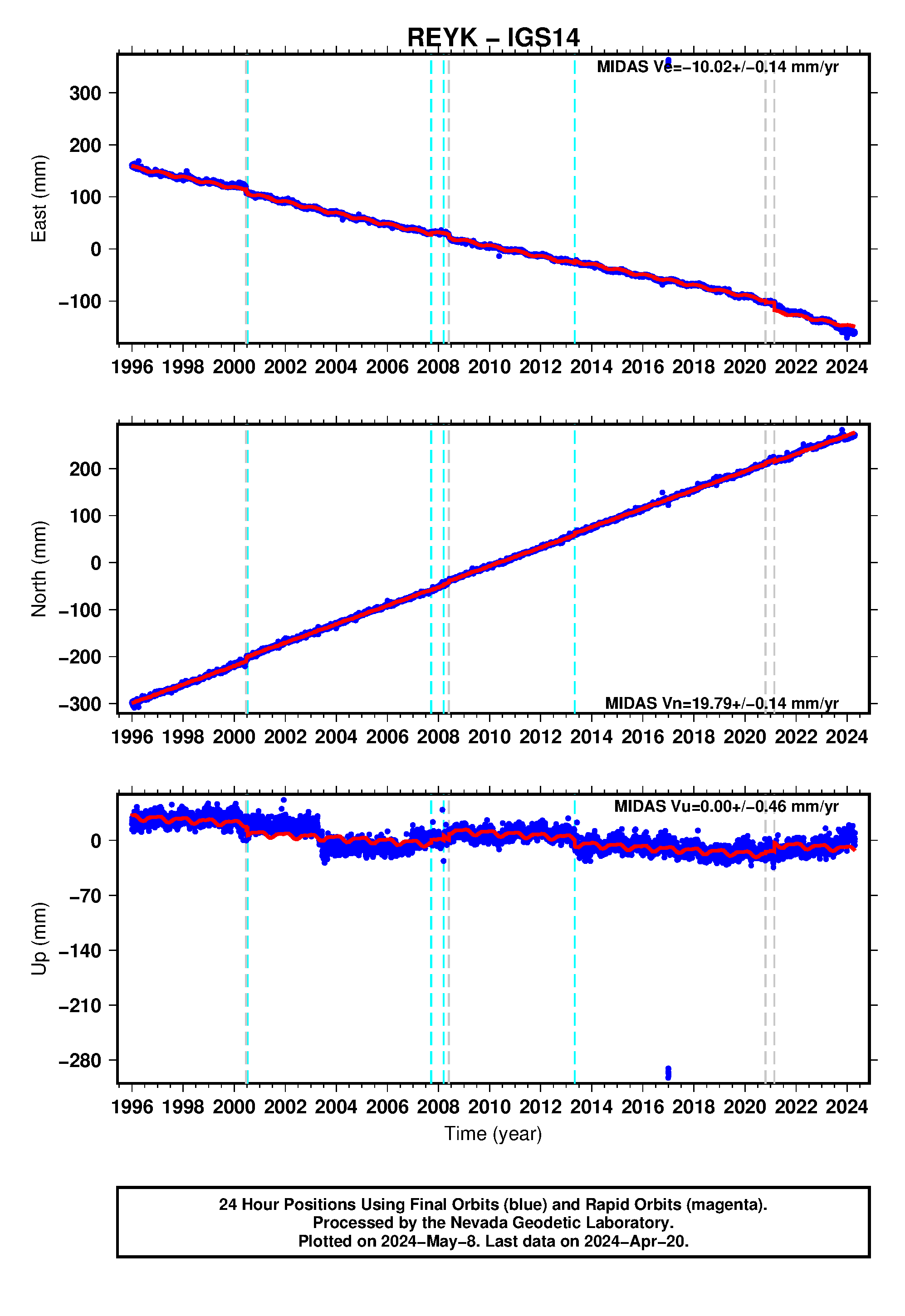Measuring plate motion with GPS | Lessons on Plate Tectonics
Index
Goal
Students are able to describe in general terms how a Global Positioning System (GPS) works and then to show GPS data as velocity vectors. They can add those vectors graphically and infer that Iceland is rifting.
Context
Audience
This lesson was developed for high school and middle school students, grades 6 - 12. However, its focus on data makes it adaptable for introductory college courses.
Teaching Time
Two class sessions (45 - 55 minutes).
Skills and concepts that students must have mastered
Students should be familiar with graphing. If they flounder, the lesson “Introduction to graphing of GPS data” is designed for novice graphers.
How the lesson is
situated in the course
This lesson falls after “Plate tectonics preview,” teaching students about GPS in the context of divergent plate boundaries.
Next Generation Science Standards
Performance Expectations: MS-ESS2-2, MS-ESS3-2, and HS-ESS2-1.
Objectives
Students will be able to:
- Model and describe the general set up of a GPS—how monuments receive signals from multiple satellites
- Interpret time series plots (position vs. time) qualitatively and quantitatively and represent time series data as velocity vectors, to scale, on a map
- Add vectors graphically to create a total horizontal velocity vector
- Make geological sense of two specific total velocity vectors in Iceland
- Apply knowledge of time series graphs to an abstract map
- Explore tectonic plate motions via velocity vectors on UNAVCO’s Velocity Viewer.
Summary
This lesson teaches middle and high school students to understand the architecture of GPS—from satellites to research quality stations on the ground. This is done with physical models and a presentation. Then students learn to interpret data for the station’s position through time (“time series plots”). Students represent time series data as velocity vectors and add the vectors to create a total horizontal velocity vector. They apply their skills to discover that the Mid-Atlantic Ridge is rifting Iceland. They cement and expand their understanding of GPS data with an abstraction using cars and maps. Finally, they explore GPS vectors in the context of global plate tectonics.
The lesson has an optional prequel, “Introduction to graphing of GPS data,” designed for students who cannot yet graph earth science data skillfully or confidently. Its first two parts teach students to graph position vs. time, and its last part dovetails with this lesson. It teaches about velocity vectors by graphing position data over five years.
Organization
This lesson consists of three core parts:
- Modeling GPS stations (or “monuments”) and the satellite network that feeds time signals to the monuments.
- Making sense of GPS data: understanding time series data in order to develop total horizontal velocity vectors for Iceland.
- Applying knowledge in a more abstract way and on a global scale.
Download Materials
Teacher materials

All teacher and student files bundled
41 MB • v: August 2016
Individual files:
See below in the DATA IN THIS RESOURCE for current links to the data
6 MB • v: August 2016
11 MB • v: August 2016
This PowerPoint accompanies the lesson.
Student materials
5 MB • v: August 2016
Data in this Resource
- HOFN GPS Station:
- HOFN time series datalink under 24 hour final solutions, IGS14, as env (east-north-vertical). The time series data is in ascii text, available through the Nevada Geodetic Laboratory, University of Nevada-Reno.
- HOFN Time series plot

- HOFN station page with additional reference frames, station plots, and data solutions.
- Source: Nevada Geodetic Laboratory, University of Nevada Reno.
- REYK GPS Station:
- REYK time series data link under 24 hour final solutions, IGS14, as env (east-north-vertical). The time series data is in ascii text, available through the Nevada Geodetic Laboratory, University of Nevada-Reno.
- REYK Time series plot

- REYK station page with additional reference frames, station plots, and data solutions.
- Source: Nevada Geodetic Laboratory, University of Nevada Reno.
Prequel activity: Introduction to graphing of GPS data
This lesson has an optional prequel, “Introduction to graphing of GPS data,” designed for students who cannot yet graph earth science data skillfully or confidently. Its first two parts teach students to graph position vs. time, and its last part dovetails with this lesson. It teaches about velocity vectors by graphing position data over five years.
Related Lessons
Exploring plate motion and deformation in California with GPS
The next lesson in this sequence is Exploring plate motion and deformation in California with GPS
Module Development
Funding for this unit came from the Plate Boundary Observatory, NSF, NASA, the American Recovery and Reinvestment Act, and UNAVCO. Authors are Roger Groom (Mt. Tabor Middle School), Cate Fox-Lent (UNAVCO), Shelley Olds (UNAVCO), and Nancy West (Quarter Dome Consulting).
Last modified: 2020-11-02 16:31:11 America/Denver
)





 Teacher Guide [pdf]
Teacher Guide [pdf]  [docx]
[docx] Presentation [pptx]
Presentation [pptx]